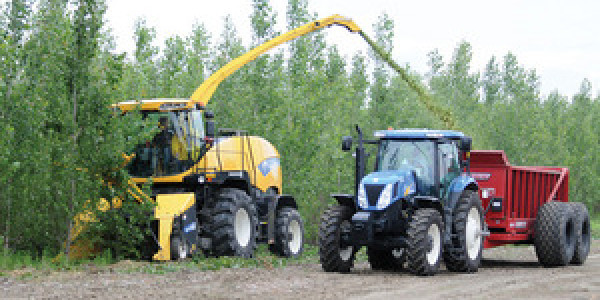By Anna Simet | August 20, 2013 When Zeachem was scouting a location for the company’s 250,000-gallon-per-year demonstration-scale biorefinery, locating next to a pre-existing, 28,000-acre hybrid poplar plantation in Boardman, Ore., was a no-brainer. As Zeachem’s primary partner, Forest Stewardship Council-certified GreenWood Tree Farm Fund is under contract to harvest, chip and transport poplar feedstock to the biorefinery, which consumes 10 bone dry tons (BDT) per day and is located just five miles away. The company will continue to supply Zeachem with hybrid poplar when it completes its first commercial plant. Poplar trees and some other types of dedicated energy crops offer a distinct advantage over biomass residuals—much more feedstock per acre, says Carrie Atiyeh of Zeachem. “If you look at the volume of biomass you’re able to produce per acre from poplar trees, it’s in the range of about 10 to 15 bone dry tons (BDT) per acre, so it has a very high density,” she says. “Biomass residuals, depending on type and location, amount to about 2 to 3 tons per acre. Poplar allows for a much smaller footprint in terms of the number of acres needed, and that cuts down on managing and transportation costs, and emissions profiles.” Poplar trees mature in 3 years and regenerate after being cut at the stem, only needing to be replanted after five harvests, or 15 years, Atiyeh says. “We call it our ‘storage-on-the-stump’ strategy, part of which is co-locating our refineries with our feedstock source, as it really minimizes the logistical costs of our biofuel and biochemical production.” Wheat straw, abundant in the region, is also used at the plant. Atiyeh describes the company’s feedstock strategy as utilizing 60 to 70 percent from a dedicated energy crop, and ag residue for the remainder. Technology and the Future In a nutshell, Zeachem’s technology platform uses hydrolysis to break down biomass into sugars, which are fermented to produce acetic acid. The acetic acid may be purified into an intermediate chemical used in the production of paint or inks—a $16 billion annual global market—or be sent through a recovery and conversion process to produce ethyl acetate. The ethyl acetate can be sold into the coating and adhesive market, or reacted with hydrogen to produce cellulosic ethanol. Right now, Zeachem is continuing to optimize production at its demo unit to collect all data needed to bring on line its first commercial plant. “We’re operating on what we call ‘campaign mode,” which means the plant is running for a certain amount of time to meet specific performance target in terms of production and efficiency, making sure all individual process units are optimized,” Atiyeh says. Chemicals produced at the demonstration plant are being used for internal testing purposes, but Atiyeh says as larger quantities are produced, Zeachem intends to sell them into the chemical and consumer markets. The commercial facility, a 25 MMgy facility currently under development, will also be located in Boardman, adjacent to the demo plant. “A benefit here is the really tight logistics, Atiyeh reiterates. The further it is to transport feedstock, the more impacts on the economics. That’s why we liked the Boardman area—access to existing resources. “That’s a strategy we’re procuring as we move forward into commercial production.” Author: Anna Simet Managing Editor, Biomass Magazine asimet@bbiinternational.com 701-751-2756 Taylor Scott International
More For Less








